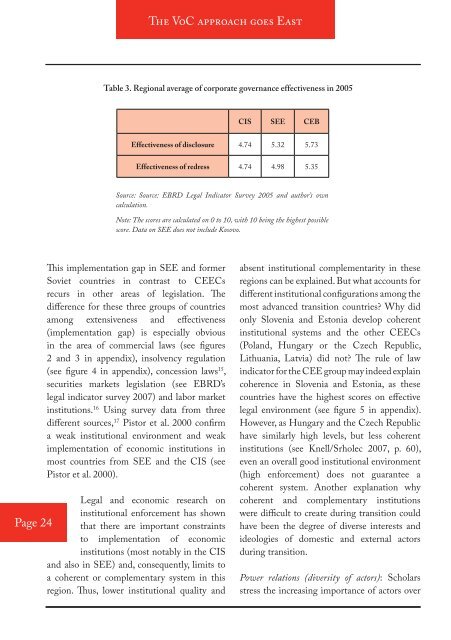Heft36 1 - SFB 580 - Friedrich-Schiller-Universität Jena
Heft36 1 - SFB 580 - Friedrich-Schiller-Universität Jena
Heft36 1 - SFB 580 - Friedrich-Schiller-Universität Jena
Create successful ePaper yourself
Turn your PDF publications into a flip-book with our unique Google optimized e-Paper software.
THE VOC EINLEITUNG APPROACH GOES EAST<br />
Table 3. Regional average of corporate governance effectiveness in 2005<br />
CIS SEE CEB<br />
Effectiveness of disclosure 4.74 5.32 5.73<br />
Effectiveness of redress 4.74 4.98 5.35<br />
Source: Source: EBRD Legal Indicator Survey 2005 and author’s own<br />
calculation.<br />
Note: The scores are calculated on 0 to 10, with 10 being the highest possible<br />
score. Data on SEE does not include Kosovo.<br />
This implementation gap in SEE and former<br />
Soviet countries in contrast to CEECs<br />
recurs in other areas of legislation. The<br />
difference for these three groups of countries<br />
among extensiveness and effectiveness<br />
(implementation gap) is especially obvious<br />
in the area of commercial laws (see figures<br />
2 and 3 in appendix), insolvency regulation<br />
(see figure 4 in appendix), concession laws 15 ,<br />
securities markets legislation (see EBRD’s<br />
legal indicator survey 2007) and labor market<br />
institutions. 16 Using survey data from three<br />
different sources, 17 Pistor et al. 2000 confirm<br />
a weak institutional environment and weak<br />
implementation of economic institutions in<br />
most countries from SEE and the CIS (see<br />
Pistor et al. 2000).<br />
Legal and economic research on<br />
institutional enforcement has shown<br />
Seite Page page 24<br />
that there are important constraints<br />
to implementation of economic<br />
institutions (most notably in the CIS<br />
and also in SEE) and, consequently, limits to<br />
a coherent or complementary system in this<br />
region. Thus, lower institutional quality and<br />
absent institutional complementarity in these<br />
regions can be explained. But what accounts for<br />
different institutional configurations among the<br />
most advanced transition countries? Why did<br />
only Slovenia and Estonia develop coherent<br />
institutional systems and the other CEECs<br />
(Poland, Hungary or the Czech Republic,<br />
Lithuania, Latvia) did not? The rule of law<br />
indicator for the CEE group may indeed explain<br />
coherence in Slovenia and Estonia, as these<br />
countries have the highest scores on effective<br />
legal environment (see figure 5 in appendix).<br />
However, as Hungary and the Czech Republic<br />
have similarly high levels, but less coherent<br />
institutions (see Knell/Srholec 2007, p. 60),<br />
even an overall good institutional environment<br />
(high enforcement) does not guarantee a<br />
coherent system. Another explanation why<br />
coherent and complementary institutions<br />
were difficult to create during transition could<br />
have been the degree of diverse interests and<br />
ideologies of domestic and external actors<br />
during transition.<br />
Power relations (diversity of actors): Scholars<br />
stress the increasing importance of actors over
















